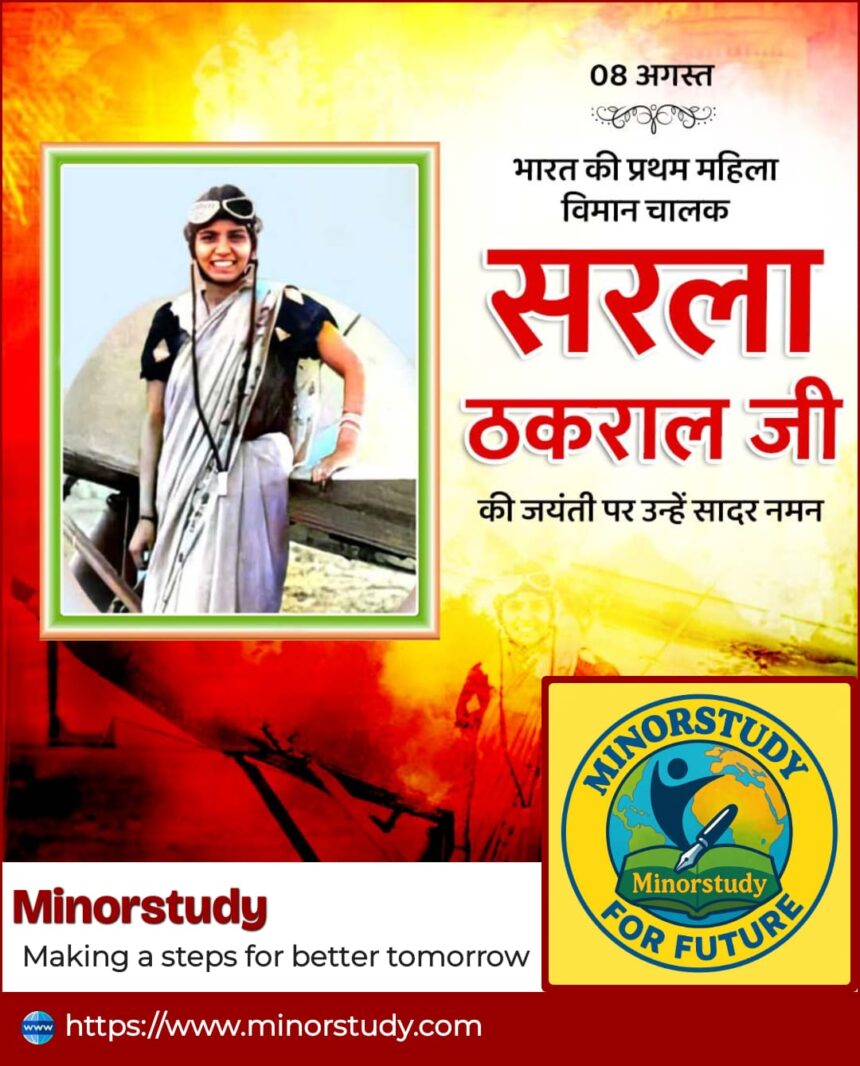Inspiring Facts About Sarla Thakral – India’s First Woman Pilot Who Broke Barriers
Hearty Introduction
Hearty congratulations to all those who cherish the inspiring stories of Indian history, because today we remember and celebrate one of the most extraordinary women of our nation – Sarla Thakral. Known as India’s first woman to earn a pilot’s license, Sarla was not just a pioneer in aviation but also a symbol of courage, determination, and progressive thinking. At a time when women were largely confined to traditional roles, she soared high—literally and figuratively—proving that the sky was never the limit.
Her life is a blend of adventure, resilience, and creativity, and her journey continues to motivate young dreamers, especially women, across the country.
History of Sarla Thakral
Sarla Thakral was born in 1914 in Delhi, during a period when India was still under British colonial rule. From a young age, she displayed a spirit of independence and an eagerness to explore new paths.
At just 16 years old, she married P.D. Sharma, an airmail pilot belonging to a family deeply connected with aviation—nine of his family members were pilots. Encouraged by her husband and in-laws, Sarla enrolled at the Lahore Flying Club.
In 1936, at the age of 21, she achieved the historic milestone of becoming the first Indian woman to fly an aircraft and obtain an ‘A’ license, which allowed her to fly small planes solo. She completed 1,000 hours of flying before moving toward further training for the commercial pilot’s license.
Tragically, her husband died in a plane crash in 1939. The outbreak of World War II further disrupted civil aviation, forcing her to step away from flying. But Sarla’s indomitable spirit led her into other creative fields like painting, textile designing, and even entrepreneurship.
Important Facts About Sarla Thakral
First Indian Woman Pilot – Earned her pilot’s license in 1936 at age 21.
Flying Hours – Accumulated over 1,000 flying hours before World War II halted her progress.
Strong Support System – Her husband and in-laws actively encouraged her flying dreams.
War Disruption – WWII caused the suspension of civil aviation, changing her career path.
Versatile Career – Later became a painter, designer, and successful businesswoman.
Cultural Icon – Inspired generations of women to enter male-dominated fields.
Legacy of Courage – Continues to be celebrated as a symbol of empowerment.
Timeline of Sarla Thakral’s Life
| Year | Event |
|---|---|
| 1914 | Born in Delhi, India |
| 1930 | Married P.D. Sharma at the age of 16 |
| 1936 | Earned pilot’s ‘A’ license, became first Indian woman pilot |
| 1939 | Husband’s death in an air crash |
| 1940s | Left aviation due to WWII, pursued art and design |
| Post-1940s | Became a successful textile designer and painter |
| 2008 | Passed away at the age of 94 |
Significance of Sarla Thakral in Indian History
Sarla’s achievements were revolutionary in an era when women’s participation in public life was limited. She redefined societal norms by:
Challenging Gender Stereotypes – Proved women could excel in aviation.
Paving the Way for Future Generations – Inspired many female pilots like Harpreet De Singh and Avani Chaturvedi.
Encouraging Women’s Education – Her journey highlighted the importance of skill development for women.
Cultural Symbol – Became an icon of progressive India before independence.
Observance & Cultural Relevance
Although there’s no official national day dedicated to Sarla Thakral, aviation enthusiasts and women’s empowerment groups often remember her on International Women’s Day and National Girl Child Day. Her story is also taught in inspirational modules in schools and featured in various exhibitions on Indian women achievers.
Wishes & Tribute Messages
“Salute to Sarla Thakral, who proved that determination can make the impossible possible.”
“Your wings inspire every dreamer to fly higher, Ma’am!”
“You showed us that courage has no gender—thank you for paving the way.”
FAQs About Sarla Thakral
Q1. Who was Sarla Thakral?
Sarla Thakral was the first Indian woman to earn a pilot’s license in 1936.
Q2. How old was she when she became a pilot?
She was just 21 years old.
Q3. Did Sarla Thakral continue flying after WWII?
No, WWII halted civil aviation, and she shifted to art and design.
Q4. What other careers did she pursue?
She became a textile designer, painter, and businesswoman.
Q5. Why is Sarla Thakral important in Indian history?
She broke gender barriers in aviation and inspired countless women to pursue unconventional careers.
Important Points for Life
Support from family can be a game-changer in achieving dreams.
Early opportunities can shape an entire life’s journey.
Adversity can open new doors to different successes.
Role models like Sarla remind us to be fearless.
Impact on Daily Life
Sarla’s life teaches us that determination can break through any societal barrier. For young girls, she stands as proof that careers in science, aviation, and leadership are attainable goals. For society, her journey encourages acceptance, equal opportunities, and respect for women’s ambitions.
Conclusion
Sarla Thakral’s life is more than just the story of India’s first woman pilot—it’s a testament to courage, adaptability, and self-belief. She lived through love, loss, and societal challenges but never allowed her spirit to be confined. Her journey from the cockpit to the canvas is an inspiration for everyone to chase dreams fearlessly, even when life changes course.
Her wings may have rested, but her story continues to soar in the hearts of millions.








